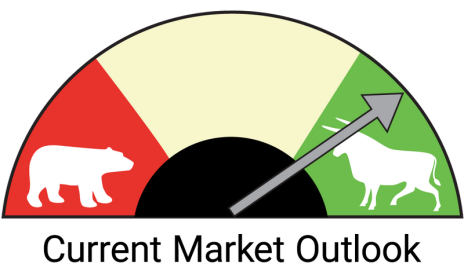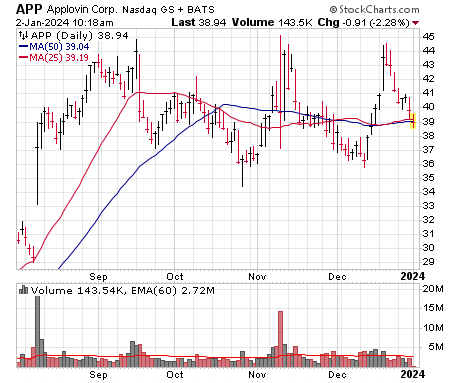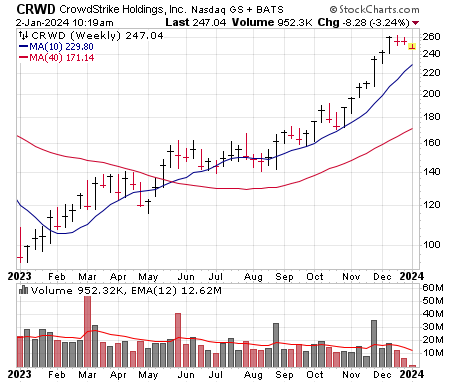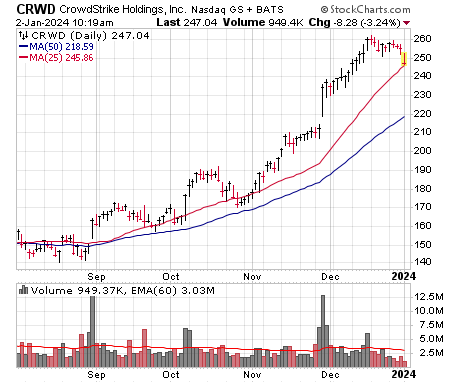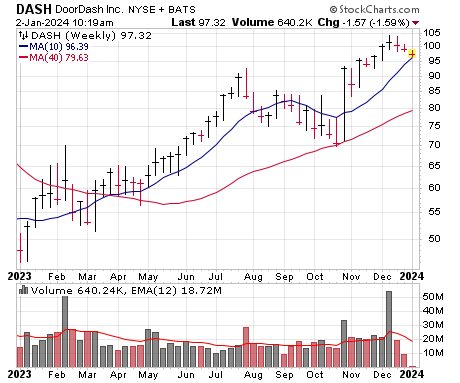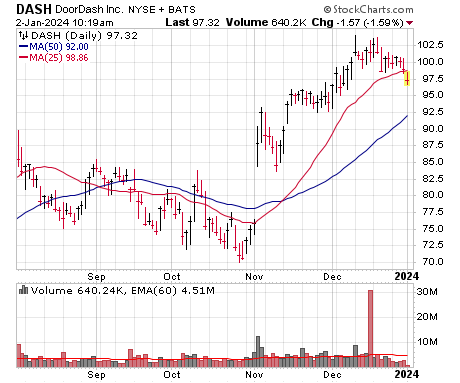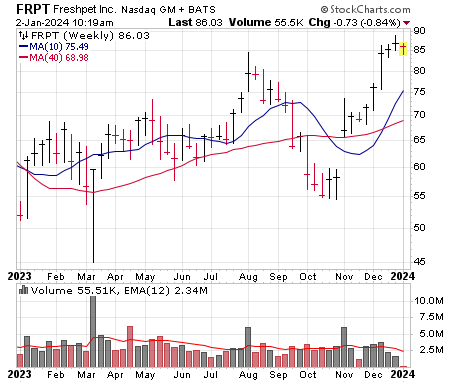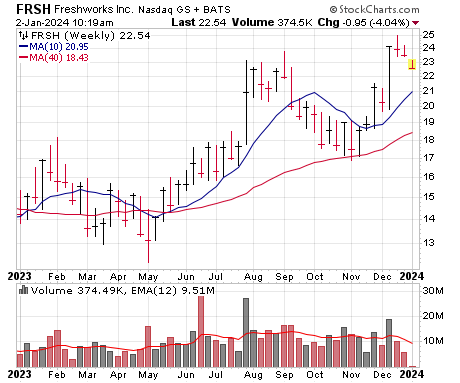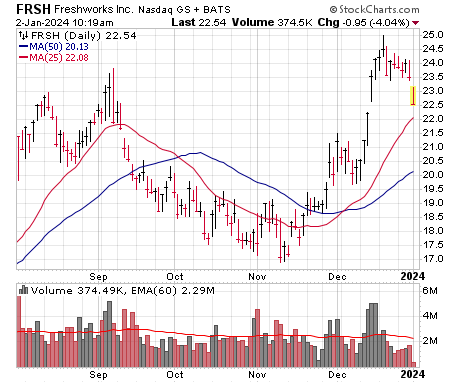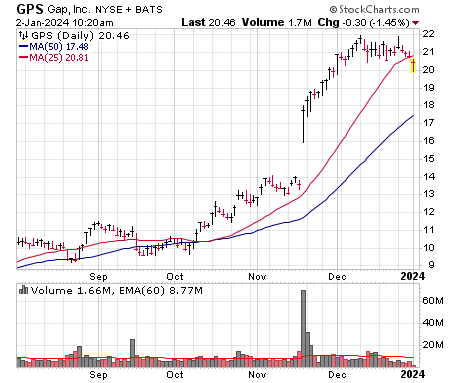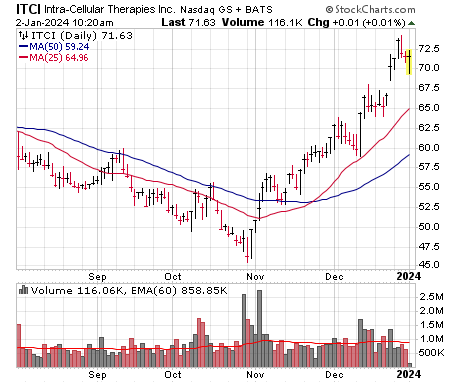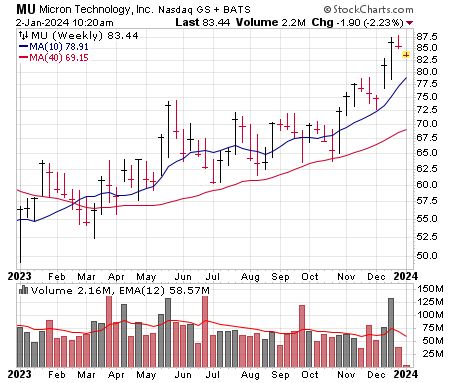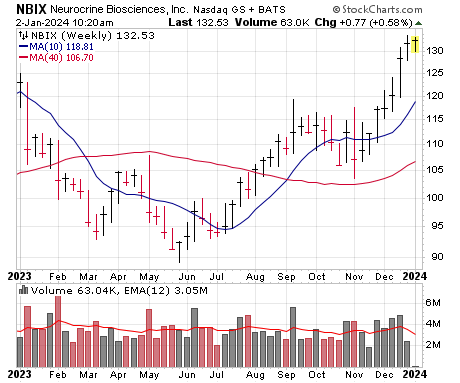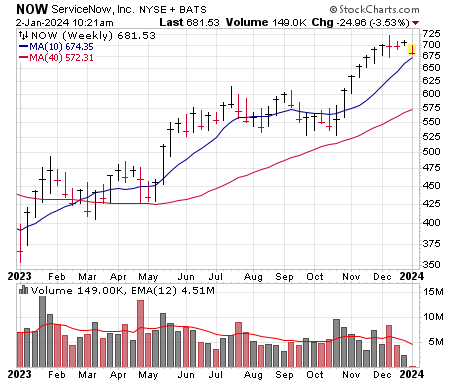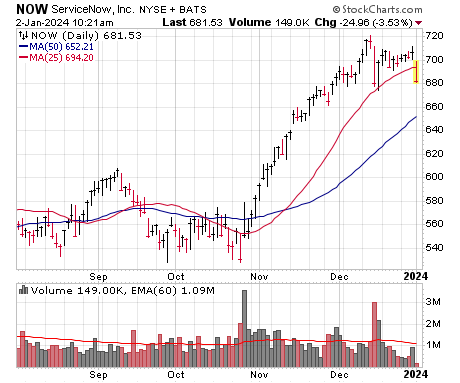Early January Is Usually Tricky
Happy New Year! Now that the calendar has flipped, early January is upon us, and that’s almost always a tricky time: There are many crosscurrents that pop up, from profit taking for tax reasons, re-positioning among nimble large investors, and next week, a couple of big industry conferences when many firms will release early 2024 guidance. Combine that with the market’s straight-up move since the start of November and today’s action wasn’t a total surprise and is a reason why we’ve been advising picking your spots of late. If you’re looking for something to worry about, we’d say that growth stocks, which led the way up in November, stalled out three weeks ago, so that could be a canary in a coal mine of sorts—but at this point, we’re seeing sharp-but-reasonable downside action in many stocks and indexes that have had big runs. If that changes, of course, we’ll alter our stance, but right now we’re thinking the next couple of weeks will likely prove tricky, but the path of least resistance remains up. We’ll keep our Market Monitor at a level 8, though we’ll be in touch if that changes.
This week’s list has something for everyone, from newer names trying to emerge to established leaders that have rested for two or three weeks. Our Top Pick is Neurocrine Biosciences (NBIX), which has moved out on the upside and has excellent numbers, all while biotech stocks remain in favor.
Price |
| Applovin (APP) |
| CrowdStrike (CRWD) |
| DoorDash (DASH) |
| Freshpet (FRPT) |
| Freshworks (FRSH) |
| Gap Inc (GPS) |
| Intra-Cellular Technologies (ITCI) |
| Micron Technology (MU) |
| Neurocrine Biosciences (NBIX) ★ Top Pick ★ |
| ServiceNow (NOW) |
Stock 1
Applovin (APP)
Price |
Why the Strength
Applovin specializes in optimization strategies for mobile marketers. For years, Applovin churned out smartphone games that allowed the business to harvest user data and build demographic groups to sell to advertisers. That business looked close to death when Apple put vast restrictions on user data collection two years ago but credit this firm’s management with making an impressive pivot into AI-powered advertising optimization software. Applovin’s system, called Axon 2.0, has been shattering expectations—in Q3, the software side of Applovin (from Axon) lifted 65% and now makes up nearly 60% of revenue, while EBITDA boomed 91%. Axon 2.0 uses lots of data to identify and target users for marketers, so Applovin’s core clientele is still on board, while management thinks the AI angle will open up new markets. Right now, Applovin is testing how to identify and target users through web-connected televisions (CTVs), where manufacturer privacy rules are much looser compared to mobile devices. Applovin’s original mobile games division has been downsized a lot, but still produced sales totaling $360 million last quarter and is positive on an EBITDA basis, and the top brass believes it will likely stop shrinking soon, which will help the focus remain on Axon. Management is making its business more appealing for shareholders by continuing to buy back shares (Q3 share count was down 5.7%) while lowering and pushing out debt maturities. We think it’s a great story that’s still being discovered, with 524 funds owning shares at the end of September up from 431 and 372 the prior two quarters.
Technical Analysis
APP came public in mid-2021, got up to 116 at the market top and then lost more than 90% of its value by the end of 2022. However, as Axon began cranking out excellent results, shares turned up last year, rallying into the mid-40s by September before finally taking a breather. Now APP has spent 15 weeks consolidating the huge rally—if it can get going, we think shares can have a great run. We’ll set our buy range up from here, thinking a buying wave can turn the trend up.
| Market Cap | $13.4B | EPS $ Annual (Dec) | ||
| Forward P/E | 25 | FY 2021 | 0.09 | |
| Current P/E | 136 | FY 2022 | -0.52 | |
| Annual Revenue | $3.03B | FY 2023e | 0.87 | |
| Profit Margin | 12.6% | FY 2024e | 1.60 | |
| Qtrly Rev | Qtrly Rev Growth | Qtrly EPS | Qtrly EPS Growth | |
| ($M) | (vs. yr-ago-qtr) | ($) | (vs. yr-ago-qtr) | |
| Latest qtr | 864 | 21% | 0.30 | 400% |
| One qtr ago | 750 | -3% | 0.22 | N/A |
| Two qtrs ago | 715 | 14% | -0.01 | N/A |
| Three qtrs ago | 702 | -11% | -0.21 | N/A |
Weekly Chart | Daily Chart |
Stock 2
CrowdStrike (CRWD)
Price |
Why the Strength
CrowdStrike is the leading new-age cybersecurity player, and it continues to grow like a weed for a few reasons. The first, of course, is the industry itself: As technology becomes more advanced and more adopted (which is a sure bet every year), the need for increased protection grows. In fact, we’re seeing that with AI, which is not only boosting security capabilities (CrowdStrike was a pioneer in using AI years ago; it sees trillions of threats a week across its customers, and then disburses solutions to the entire platform), but is enabling more advanced hacking attacks as well. The second reason is that this firm’s platform does it all (endpoint security, log management, cloud workloads, identity protection, detection and response, forensics, etc., etc.), and bigger clients are eager to consolidate on one platform that actually works, instead of five or six point solutions that have to be managed. (42% of clients now use six modules or more, while 26% use seven or more!) And third is a newer factor: Recent regulations dictate that a firm must disclose a meaningful hack within a short period of time, which unfortunately is leading more to CrowdStrike’s door of late for forensics … and likely also leading them to buy up more of its offerings to actually prevent future issues, too. The numbers here remain excellent, with strong sales, earnings and free cash flow ($2.72 per share in the first nine months of the year, vs. earnings of $2.13), and the top brass is super-bullish on the long term, thinking recurring revenue can more than triple by 2027 (to $10 billion) while earnings and free cash flow grow more than that. It quacks like an emerging blue chip.
Technical Analysis
CRWD’s off-the-bottom rally was solid but ran out of gas in June—though, instead of dipping with the market, shares moved straight sideways in a tight range. Things began to improve after earnings in August, though the market still prevented the stock from getting very far, with a dip back toward the prior highs in October. But since the market got going, CRWD has performed beautifully, surging above 250 before resting to end the year and then getting slapped around today. We’re OK grabbing shares here or on further weakness.
| Market Cap | $61.3B | EPS $ Annual (Jan) | ||
| Forward P/E | 69 | FY 2022 | 0.67 | |
| Current P/E | 99 | FY 2023 | 1.54 | |
| Annual Revenue | $2.85B | FY 2024e | 2.95 | |
| Profit Margin | 26.6% | FY 2025e | 3.72 | |
| Qtrly Rev | Qtrly Rev Growth | Qtrly EPS | Qtrly EPS Growth | |
| ($M) | (vs. yr-ago-qtr) | ($) | (vs. yr-ago-qtr) | |
| Latest qtr | 786 | 35% | 0.82 | 105% |
| One qtr ago | 732 | 37% | 0.74 | 106% |
| Two qtrs ago | 693 | 42% | 0.57 | 84% |
| Three qtrs ago | 637 | 48% | 0.47 | 57% |
Weekly Chart | Daily Chart |
Stock 3
DoorDash (DASH)
Price |
Why the Strength
DoorDash is one of the big delivery operators, and while the story isn’t new—delivery of everything hit the mainstream back in the pandemic days of 2020/2021—its nearly a sure thing that the market is going to grow quickly for many years to come. Indeed, as of a couple of quarters ago, just 12% of U.S. restaurant orders were delivery, compared with north of 20% in the U.K. and 30% for Canada, and that says nothing about other areas like groceries (where reports suggest orders doubled last year) and convenience stores (plus newer forays into flowers, pet supplies, etc.), where DoorDash is a growing player and reportedly has had good success thus far. (A report out this morning suggested that the firm is looking more closely at taking advantage of international markets, too.) Of course, numbers-wise, restaurants are what count most here, and on that front, the metrics are encouraging—in the last quarterly report, management said that not only are new users growing at double-digit rates, but that they’re sticking around, with retention running ahead of all prior years save the 2020, pandemic-affected cohort. Plus, on a yearly basis, every batch of new users continues to increase their usage of DoorDash over time. All in all, order growth is slowing a bit but remains solid (up 24% in Q3), while revenue lifted 27% and EBITDA boomed to $344 million, up nearly four-fold from the year before. To be fair, analysts see top-line growth slowing to just 18% next year, though our guess is that will prove conservative and EBITDA will continue to kite higher. While not as sexy as some other stories, DoorDash should crank out solid and reliable growth for a long time to come given the industry’s trends, its position in the market and management that’s consistently made good moves.
Technical Analysis
DASH enjoyed a nice, accelerating, persistent run higher after breaking out last May, getting up to nearly 93 before it turned down during the market’s summer/fall correction. Even so, the retreat wasn’t abnormal (down 25%) given the prior run, support was seen near the 40-week line and the Q3 report caused a big gap up. Admittedly, DASH hasn’t set the world on fire, but it did move to new price and RP peaks before the recent retreat. We’ll set our buy range up from here, looking for a resumption of the overall upmove as a chance to enter.
| Market Cap | $39.4B | EPS $ Annual (Dec) | ||
| Forward P/E | N/A | FY 2021 | -1.39 | |
| Current P/E | N/A | FY 2022 | -3.68 | |
| Annual Revenue | $8.15B | FY 2023e | -1.15 | |
| Profit Margin | N/A | FY 2024e | -0.18 | |
| Qtrly Rev | Qtrly Rev Growth | Qtrly EPS | Qtrly EPS Growth | |
| ($B) | (vs. yr-ago-qtr) | ($) | (vs. yr-ago-qtr) | |
| Latest qtr | 2.16 | 27% | -0.19 | N/A |
| One qtr ago | 2.13 | 33% | -0.44 | N/A |
| Two qtrs ago | 2.04 | 40% | -0.41 | N/A |
| Three qtrs ago | 1.82 | 40% | -1.65 | N/A |
Weekly Chart | Daily Chart |
Stock 4
Freshpet (FRPT)
Price |
Why the Strength
Freshpet is just the kind of growth-oriented, small-cap name that may finally see its stock get going now that the broad market is in gear. The story is simple but very strong: Freshpet is one of the leading fresh pet food providers (the vast majority of it for dogs), which is more expensive than kibbles but is shown to lead to healthier, longer-lived pets—and a growing number of households are willing to pay up because of that. Demand here has never been an issue, nor has the potential: Freshpet’s revenues have grown at least 25% in 21 straight quarters, and given that only about 15% of dog-owning households are customers, there’s plenty of white space to expand. The problem, though, was on the cost side, with heavy investments and some supply chain issues sinking the bottom line in the years after the pandemic broke out—but that’s mostly in the past now, with some bold moves (big advertising campaign and a series of price hikes) paying off, all while logistics and quality control costs are way down, causing margins to leap. (Helping the cause is a production ramp at a new facility; another line should be operational by Q3 of this year.) Best of all, there should be a lot more of that in the years ahead: Last year the top brass laid out 2027 targets, thinking it can expand sales at a 25% clip and grow margins, too (45% gross margin target compared to 40% today). In the meantime, business is good and getting better—in Q3, volume growth accelerated for the fourth straight quarter (up 23%) while revenues leapt 33% and EBITDA came in at $23 million, up from $4 million a year ago, while all sub-metrics (including household penetration and repeat buying activity) were strong. Analysts see 25% top-line growth this year, with EBITDA continuing to surge.
Technical Analysis
FRPT got off its knees in late 2022 and then spent about nine months building a launching pad, with a breakout attempt in August. But the market’s correction pulled the stock back down in a tough 36% correction. Even so, the stock’s character changed after Q3 earnings, with a strong gap up and, really, there’s been no selling since, with the stock up 10 of the past 11 weeks, notching new price highs. We’ll set our buy range down a bit, thinking a normal exhale will be buyable.
| Market Cap | $4.19B | EPS $ Annual (Dec) | ||
| Forward P/E | N/A | FY 2021 | -0.69 | |
| Current P/E | N/A | FY 2022 | -1.29 | |
| Annual Revenue | $718M | FY 2023e | -0.84 | |
| Profit Margin | N/A | FY 2024e | -0.19 | |
| Qtrly Rev | Qtrly Rev Growth | Qtrly EPS | Qtrly EPS Growth | |
| ($M) | (vs. yr-ago-qtr) | ($) | (vs. yr-ago-qtr) | |
| Latest qtr | 201 | 33% | -0.15 | N/A |
| One qtr ago | 183 | 26% | -0.35 | N/A |
| Two qtrs ago | 168 | 27% | -0.52 | N/A |
| Three qtrs ago | 166 | 43% | -0.06 | N/A |
Weekly Chart | Daily Chart |
Stock 5
Freshworks (FRSH)
Price |
Why the Strength
Generative artificial intelligence (GenAI) is being called the financial markets story of 2023, as it has dramatically enhanced the valuations of companies across many industries. On that score, cloud-based software-as-a-service (SaaS) provider Freshworks is capturing attention thanks to its comprehensive adoption of AI across its entire spectrum of offerings. Freshworks’ flagship product is Freshdesk, a widely used messaging service that helps businesses manage customer inquiries, resolve issues and provide personalized support across multiple channels (including email, phone, chat and social media). But causing most of the buzz is Freshworks’ new GenAI capabilities across its product portfolio, including a beta program called Freddy Insights, which helps customers identify a range of issues proactively, along with Freddy Copilot—a comprehensive AI assistant for all Freshworks users, which management believes will “unlock more value out of our existing product suite.” During its latest earnings call, the top brass said it’s also focused on strengthening its AI capabilities for marketers to improve campaign creation, while boosting efficiency, conversion rate and customer satisfaction. As a result, Freshworks was just named by a major Wall Street institution as one of its top GenAI opportunities in the customer service space (a reason for the stock’s strength). Another reason for the enthusiasm is the firm’s renewed focus on targeting larger, higher-yielding customers: In Q3, the number of clients spending over $50,000 annually with the firm grew 32% year-over-year, making up 46% of total recurring revenue. To be fair, growth here isn’t that crazy, up 19% to 20% each of the past three quarters, but profits are lifting off and topping expectations, margins are healthy and analysts see more of the same in 2024.
Technical Analysis
FRSH went public in 2021 and was crushed during the bear phase and then bottomed out for months; shares looked like they were getting going in the summer, but the Q2 earnings move ran into a wall with the market. But the result was a very nice-looking launching pad, with support at the 40-week line, solid weekly buying volume clues—and then a run back to the prior highs before today’s growth stock-induced wallop. We’re OK buying a little around here with a stop under the 50-day line.
| Market Cap | $6.94B | EPS $ Annual (Dec) | ||
| Forward P/E | 78 | FY 2021 | -0.10 | |
| Current P/E | 126 | FY 2022 | -0.07 | |
| Annual Revenue | $570M | FY 2023e | 0.24 | |
| Profit Margin | 18.5% | FY 2024e | 0.30 | |
| Qtrly Rev | Qtrly Rev Growth | Qtrly EPS | Qtrly EPS Growth | |
| ($M) | (vs. yr-ago-qtr) | ($) | (vs. yr-ago-qtr) | |
| Latest qtr | 154 | 19% | 0.08 | N/A |
| One qtr ago | 145 | 19% | 0.07 | N/A |
| Two qtrs ago | 138 | 20% | 0.03 | N/A |
| Three qtrs ago | 133 | 26% | 0.01 | N/A |
Weekly Chart | Daily Chart |
Stock 6
Gap Inc (GPS)
Price |
Why the Strength
U.S. holiday sales from both in-store and online channels grew 3% between November 1 and December 24, according to data released by Mastercard, with apparel sales rising over 2% from a year ago. However, this was below last year’s 8% rise as consumers continue to feel the sting of inflation and higher interest rates. The challenging retail environment has pressured big-name apparel retailer Gap (covered in the November 20 issue), which saw its third-quarter revenue decline 7%, led by an 11% sales loss for its Banana Republic business and an 18% sales drop for its Athleta segment. But investors see a turnaround ahead: The company has been aggressive in its efforts to revive sales, including tightening inventories and increasing its digital footprint (online sales now account for 32% of total revenue, making Gap less reliant on out-of-favor shopping malls), and management recently stated its intent to “re-set the company for long-term success” with additional initiatives, including improving product assortments, balancing essentials with new trends and adjusting pricing strategy to reflect “jaw-dropping value” to customers. Moreover, the top brass thinks it can grow its Old Navy brand (the number two apparel brand in the U.S.) by over 700 stores in North America (from around 1,200 today) in the coming years. To that end, analysts forecast Old Navy to be a sales leader going forward as it introduces trendier clothing to its lineup. Meanwhile, Gap is also working to re-position Banana Republic with an increased focus on aesthetics, fabrication and quality; it sees an opportunity for the line to “thrive in the quiet luxury space,” with its cashmere and leather product offerings already “translating well.” Most importantly, after a rough 2022, earnings are crushing estimates (59 cents in Q3 vs. 19 cents expected) and Wall Street sees the bottom line doubling within a few years even after the recent rebound.
Technical Analysis
We missed getting into GPS in November as the stock never pulled back into our buy range after its earnings-induced pop. The stock rallied an additional four points after that, but it finally hit some resistance near 22—though, since then, it’s basically just marked time while the 25-day line has caught up. A deeper retreat is always possible, but the evidence tells us the buyers are certainly in control. We’re OK entering here or on dips of a few more dimes.
| Market Cap | $7.75B | EPS $ Annual (Jan) | ||
| Forward P/E | 17 | FY 2022 | 1.44 | |
| Current P/E | 111 | FY 2023 | -0.40 | |
| Annual Revenue | $14.8B | FY 2024e | 1.17 | |
| Profit Margin | 6.8% | FY 2025e | 1.20 | |
| Qtrly Rev | Qtrly Rev Growth | Qtrly EPS | Qtrly EPS Growth | |
| ($B) | (vs. yr-ago-qtr) | ($) | (vs. yr-ago-qtr) | |
| Latest qtr | 3.77 | -7% | 0.59 | -17% |
| One qtr ago | 3.54 | -8% | 0.34 | 325% |
| Two qtrs ago | 3.28 | -6% | 0.01 | N/A |
| Three qtrs ago | 4.24 | -6% | -0.75 | N/A |
Weekly Chart | Daily Chart |
Stock 7
Intra-Cellular Technologies (ITCI)
Price |
Why the Strength
Intra-Cellular produces the only treatment that’s FDA approved for both Bipolar I and Bipolar II disorders (both on its own and in conjunction with other treatments), manic episodes that are so intense they require hospitalization and less-intense episodes that last longer, respectively. Some 4% of the U.S. population suffers from one version of bipolar, which in its most extreme form can result in suicide. Intra-Cellular’s treatment, lumateperone – sold under the name Caplyta – is a once-a-day pill first launched commercially in 2020 when originally approved for adult schizophrenia, and prescription growth was solid—but when the bipolar approvals came near the end of 2021, growth accelerated and has pushed sales all the way to $126 million in Q3, up 75% from the year prior. For full-year 2023, management in November raised its projection for revenue to come in at $460 to $470 million, an 88% rise on the high end, and still sees plenty of runway for the drug in its approved uses. Intra-Cellular is also pursuing expanding Caplyta to major depressive disorders and indications that mix features of bipolar, which could be even bigger than bipolar itself. Management expects to present findings from trials in Q1 as well as hold discussions with the FDA and European Union regulators about the pathway to expansion. Caplyta accounts for just about all of the business’ revenue, so the company is progressing on developing similar drugs for use on generalized anxiety, opioid use and recovery and non-hallucinogenic treatment for a variety of psychiatric disorders. The ramp-up means the business still loses money, but the main focus is on revenue growth (analysts see 41% growth in 2024) and label expansion.
Technical Analysis
ITCI spent much of the past two years in range between 42 and 67 – and much of 2023 on the low end of that band, including a wicked decline into the mid-40s in October. Good Q3 results and the turn-up in the market in November kicked off the rally back to the highs, and some recent M&A activity in the biotech space helped ITCI gap to new price highs. If you want in, aim for minor weakness.
| Market Cap | $6.89B | EPS $ Annual (Dec) | ||
| Forward P/E | N/A | FY 2021 | -3.50 | |
| Current P/E | N/A | FY 2022 | -2.72 | |
| Annual Revenue | $420M | FY 2023e | -1.60 | |
| Profit Margin | N/A | FY 2024e | -0.48 | |
| Qtrly Rev | Qtrly Rev Growth | Qtrly EPS | Qtrly EPS Growth | |
| ($M) | (vs. yr-ago-qtr) | ($) | (vs. yr-ago-qtr) | |
| Latest qtr | 126 | 76% | -0.25 | N/A |
| One qtr ago | 111 | 99% | -0.45 | N/A |
| Two qtrs ago | 95.3 | 172% | -0.46 | N/A |
| Three qtrs ago | 87.9 | 242% | -0.45 | N/A |
Weekly Chart | Daily Chart |
Stock 8
Micron Technology (MU)
Price |
Why the Strength
The semiconductor space is poised to enter 2024 in what many analysts expect will be the “sweet spot” for the broader industry. Specifically, a major Wall Street bank just named Micron one of its two top chip picks for the year ahead as the trend turns up, which should result in revenue “materially” outpacing inventory growth. And as artificial intelligence (AI) demand ramps up amid capacity constraints, the bank expects Micron to benefit from what it sees as a “super-cycle” in memory chips. The fiscal Q1 report (ended November 30) was the main catalyst for the stock’s recent strength, and it suggested the bank’s sanguine outlook is achievable. The results were led by revenue of $4.7 billion that increased 16% from a year ago (a huge acceleration from many quarters of shrinkage), thanks to an improving supply-demand environment, while the per-share loss of 95 cents narrowed and beat estimates by six cents. Micron expects business fundamentals to improve throughout 2024 along with pricing, with a record industry addressable opportunity projected for 2025, adding that it’s “well positioned” to take advantage of the “immense opportunities” in AI management sees across its major end markets. The company noted that generative AI use cases are expanding from the data center to the edge, with several recent announcements of AI-enabled PC and smartphone capabilities, as well as embedded AI in the auto and industrial end markets. On the data center front, Micron expects to increasingly benefit as more infrastructure operators shift budgets from traditional servers to more content-rich AI servers. Micron has always been very cyclical, and underlying trends are definitely improving: Analysts see revenues up north of 40% in the current fiscal year while the bottom line advances toward breakeven—and then booms in 2025 and beyond.
Technical Analysis
MU bottomed out in late 2022 and jaggedly rallied into May of last year when it hit a wall near 75 and began etching a solid base. The 40-week line provided support a few times and shares staged a low-volume breakout attempt in November, but it wasn’t until after the next pullback that MU showed real power, with shares rallying nicely both before and after the quarterly report. Of course, today’s drop wasn’t great looking, but it’s not out of character for the stock or abnormal on the chart. If you want in, you could start a small position here.
| Market Cap | $94.2B | EPS $ Annual (Dec) | ||
| Forward P/E | N/A | FY 2021 | 8.34 | |
| Current P/E | N/A | FY 2022 | -4.45 | |
| Annual Revenue | $16.2B | FY 2023e | -0.94 | |
| Profit Margin | N/A | FY 2024e | 5.90 | |
| Qtrly Rev | Qtrly Rev Growth | Qtrly EPS | Qtrly EPS Growth | |
| ($B) | (vs. yr-ago-qtr) | ($) | (vs. yr-ago-qtr) | |
| Latest qtr | 4.73 | 16% | -0.95 | N/A |
| One qtr ago | 4.01 | -40% | -1.07 | N/A |
| Two qtrs ago | 3.75 | -57% | -1.43 | N/A |
| Three qtrs ago | 3.69 | -53% | -1.91 | N/A |
Weekly Chart | Daily Chart |
Stock 9
Neurocrine Biosciences (NBIX) ★ Top Pick ★
Price |
Why the Strength
Neurocrine develops breakthrough treatments for patients with rare and under-addressed diseases with a focus on neurological, endocrine and psychiatric disorders. The company has three commercialized therapies, including the flagship medicine Ingrezza for treating tardive dyskinesia, a nervous system disorder that causes muscle spasms in the face, neck, arms and legs. Neurocrine’s other drugs include Orilissa (for moderate to severe endometriosis) and Oriahnn (for heavy menstrual bleeding), both of which are marketed by AbbVie, though they’re small ball compared to Ingrezza. But another big seller could be on the way: Neurocrine captured investor attention last month when its Phase III drug candidate crincerfont—for treating adults with the genetic disorder congenital adrenal hyperplasia (CAH)—was granted a breakthrough therapy designation from the FDA; the company said it plans to submit a market application with the FDA for crincerfont later this year. Additionally, Neurocrine expects to report Phase II data for five programs in 2024, including its drug NBI-568 in the treatment of schizophrenia, as well as Phase II candidates NBI-352 for treating focal onset seizures and NBI-846 for MDD-associated depression. What’s more, a recent spate of acquisitions in the pharma space has prompted not only some high-profile speculation that Neurocrine could be a prime takeover candidate for a larger drug company, but also a series of share price upgrades from analysts (further reasons for the stock’s strength). On the financial front, the company reported total revenue of nearly $500 million in Q3, up 29% from a year ago and led by Ingrezza sales, plus per-share earnings of $1.54 that beat estimates by 16%. Analysts expect 15%-ish top-line growth for 2024 while earnings move up nicely.
Technical Analysis
NBIX hit the wall just under 130 last December when one of its drugs failed to meet the main endpoint of a study. The bad news was followed by a six-month slide, but shares found support at 90 in early June before turning the corner the next month. The reversal took the stock back to 120, where NBIX rested for two months, but after a shakeout in November, the buyers have been in control, including an encouraging buying surge two weeks ago. We’re OK entering here or (preferably) on further dips.
| Market Cap | $13.0B | EPS $ Annual (Dec) | ||
| Forward P/E | 21 | FY 2021 | 1.90 | |
| Current P/E | 38 | FY 2022 | 3.47 | |
| Annual Revenue | $1.78B | FY 2023e | 3.87 | |
| Profit Margin | 41.8% | FY 2024e | 6.29 | |
| Qtrly Rev | Qtrly Rev Growth | Qtrly EPS | Qtrly EPS Growth | |
| ($M) | (vs. yr-ago-qtr) | ($) | (vs. yr-ago-qtr) | |
| Latest qtr | 499 | 29% | 1.54 | 43% |
| One qtr ago | 453 | 20% | 1.25 | 49% |
| Two qtrs ago | 420 | 35% | -0.51 | N/A |
| Three qtrs ago | 412 | 32% | 1.24 | 999% |
Weekly Chart | Daily Chart |
Stock 10
ServiceNow (NOW)
Price |
Why the Strength
A recent Gartner report predicted that $3 trillion will be spent on artificial intelligence (AI) and generative AI globally over the next three years. Continuing with the GenAI theme, one Wall Street firm just referred to it as “the most significant tech innovation since the Internet,” which is bringing disruptions that offer investable opportunities. Not surprisingly, it pegged ServiceNow (covered in the November 13 issue) to be a big player in 2024 as enterprises across the entire business spectrum adopt GenAI as part of their operations and service offerings. The company, which provides a software-based platform for businesses to digitize workflows and enhance productivity, recently expanded its Now Assist GenAI solutions portfolio with new capabilities to transform experiences and increase productivity, along with offering premium Pro Plus subscriptions. (Now Assist customers include Deloitte, Teleperformance, one of the world’s largest real estate firms, a U.S. government agency and NVIDIA, which is both a customer and ServiceNow partner.) The explosive demand for the firm’s AI-enhanced offerings was on full display in the latest quarter, when Service Now delivered subscription revenue that grew by 25% from a year ago. Customer count grew to 7,700 in Q3, with nearly 1,800 customers contributing over $1 million in annual contract value (up 20%), and with the number of clients contributing over $20 million lifting 60%. Moreover, ServiceNow said it has over 300 customers in its pipeline from every industry, with GenAI expected to serve as a “tailwind” for further growth. Indeed, we’re impressed with the fact that both sales and earnings growth are accelerating. Earnings are due January 26, with analysts looking for the bottom line to lift 22%, which is likely conservative.
Technical Analysis
NOW built a nice bottoming base for the first three months of the year and staged a solid breakout in May, but it didn’t get too far, with the 600 level (and the market’s summer/fall swoon) bringing in the sellers. Even so, the consolidation after that was proper, and NOW has acted excellently since the market low, breaking out again in November and running straight up to 720 before two good-sized wobbles, including one today. It looks like a classic buy-on-strength setup—a resumption of the overall upmove above 700 or so would produce a good risk/reward trade.
| Market Cap | $145B | EPS $ Annual (Dec) | ||
| Forward P/E | 56 | FY 2021 | 5.92 | |
| Current P/E | 71 | FY 2022 | 7.59 | |
| Annual Revenue | $8.48B | FY 2023e | 10.46 | |
| Profit Margin | 32.5% | FY 2024e | 12.72 | |
| Qtrly Rev | Qtrly Rev Growth | Qtrly EPS | Qtrly EPS Growth | |
| ($B) | (vs. yr-ago-qtr) | ($) | (vs. yr-ago-qtr) | |
| Latest qtr | 2.29 | 25% | 2.92 | 49% |
| One qtr ago | 2.15 | 23% | 2.37 | 46% |
| Two qtrs ago | 2.10 | 22% | 2.37 | 37% |
| Three qtrs ago | 1.94 | 20% | 2.28 | 56% |
Weekly Chart | Daily Chart |
Previously Recommended Stocks
| Date | Stock | Symbol | Top Pick | Original Buy Range | 1/2/24 |
| HOLD | |||||
| 12/18/23 | 133-137 | 139 | |||
| 12/4/23 | 52.5-54 | 54 | |||
| 10/16/23 | 214-218 | 252 | |||
| 12/18/23 | 47-49 | 47 | |||
| 12/18/23 | 124-127 | 128 | |||
| 9/5/23 | ★ | 161-166 | 247 | ||
| 12/18/23 | 120-124 | 115 | |||
| 12/11/23 | ★ | 45.5-48 | 54 | ||
| 11/6/23 | 86.5-89 | 96 | |||
| 11/6/23 | ★ | 33-35 | 34 | ||
| 11/13/23 | 202-208 | 214 | |||
| 12/4/23 | 106-112 | 107 | |||
| 12/11/23 | 58-60.5 | 60 | |||
| 11/6/23 | 433-445 | 491 | |||
| 12/18/23 | Monday.com | 187-193 | 178 | ||
| 12/18/23 | 46-48 | 47 | |||
| 9/5/23 | ★ | 33-34.5 | 46 | ||
| 2/27/23 | 225-230 | 482 | |||
| 11/6/23 | 29.5-31 | 36 | |||
| 11/20/23 | ★ | 86.5-89 | 102 | ||
| 11/20/23 | 101-104 | 120 | |||
| 12/4/23 | 31.5-33 | 31 | |||
| 11/20/23 | 47.5-48.5 | 50 | |||
| 12/11/23 | 187-191 | 189 | |||
| 10/30/23 | 166-169 | 189 | |||
| 11/6/23 | 77-79 | 101 | |||
| 5/8/23 | 37-39 | 58 | |||
| 12/11/23 | 22.5-24 | 24 | |||
| 12/4/23 | 505-515 | 567 | |||
| 12/4/23 | ★ | 44-46 | 46 | ||
| 12/4/23 | 257-264 | 268 | |||
| 10/2/23 | Zscaler | ZS | 165-170 | 212 | |
| WAIT | |||||
| None this week | |||||
| SELL | |||||
| 10/23/23 | 555-570 | 580 | |||
| 12/11/23 | 67-68.5 | 69 | |||
| 12/4/23 | 32.5-34 | 37 | |||
| 11/20/23 | 49-51.5 | 50 | |||
| 12/4/23 | 136-140 | 155 | |||
| 11/20/23 | 538-554 | 560 | |||
| 12/4/23 | Salesforce.com | 242-252 | 256 | ||
| 11/20/23 | Synopsis | SNPS | 517-532 | 499 | |
| DROPPED | |||||
| 12/18/23 | 123.5-126.5 | 132 | |||
| 12/18/23 | 141-145 | 149 | |||
| 12/18/23 | 170-175 | 181 | |||
| 12/18/23 | 240-245 | 252 | |||
| 12/11/23 | 171-175 | 180 | |||
| 12/11/23 | 72.5-75.5 | 81 | |||
| 12/11/23 | 68.5-71 | 74 | |||
| 12/11/23 | 305-315 | 369 | |||
The next Cabot Top Ten Trader issue will be published on January 8, 2024.

